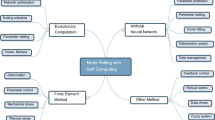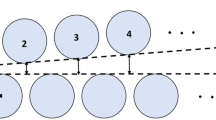Abstract
In smart manufacturing, machines are interconnected through cyber physical system (CPS) to achieve efficient manufacturing production. Manufacturing efficiency of precision magnetic scale has surfaced as an inevitable challenge. The manufacturing of precision magnetic scale requires precise flatness throughout production and handling processes. In the current technological shortcomings in magnetic scale manufacturing, any flatness defects in the scale would substantially influence its position sensing accuracy. Thus, the goal of this research is to develop and examine a hybrid mechanics model to ensure the scale’s flatness in manufacturing. This model is validated that accurate roller setting can be obtained prior to machine operation, which can significantly improve manufacturing efficiency. In this work, the proposed hybrid mechanics model is performed, validated, and compared to experimental and factory recommended results. The results have demonstrated its capability in predicting optimal leveling roller settings under given conditions, suggesting the possibility of smart manufacturing for magnetic scales.
Similar content being viewed by others
References
J. Lee, B. Bagheri and H. A. Kao, A cyber-physical systems architecture for industry 4.0-based manufacturing systems, Manuf. Letters, 3 (2015) 18–23.
M. Brettel, N. Friederichsen, M. Keller and M. Rosenberg, How virtualization, decentralization and network building change the manufacturing landscape: an industry 4.0 prospective, Int. J. Mechanical, Aerospace, Industrial, Mechatronic and Manuf. Eng., 8 (1) (2014) 37–44.
J. Wan, B. Yin, D. Li, A. Celesti, F. Tao and Q. Hua, An ontology-based resource reconfiguration method for manuf. cyber-physical systems, IEEE/ASME Trans. on Mechatronics, 23 (6) (2018) 2537–2546.
J. Davis, T. Edgar, J. Porter, J. Bernaden and M. Sarli, Smart manufacturing, manufacturing Intelligence and demand-dynamic performance, Comp. and Chem. Eng., .47 (2012) 145–156.
H. Wang, Y. Huang and A. Khajepour, Cyber-physical control for energy management of off-road vehicles with hybrid energy storage systems, IEEE/ASME Trans. on Mechatronics, 23 (6) (2018) 2609–2618.
Y. Li, C. Lv, J. Zhang, Y. Zhang and W. Ma, High-precision modulation of a safety-critical cyber-physical system: control synthesis and experimental validation, IEEE/ASME Trans. on Mechatronics, 23 (6) (2018) 2599–2608.
K. Zhu and Y. Zhang, A cyber-physical production system framework of smart CNC machining monitoring system, IEEE/ASME Trans. on Mechatronics, 23 (6) (2018) 2579–2586.
B. Chen and J. Y. Chang, Dynamic analysis of intelligent coil leveling machine for cyber-physical systems implementation, Procedia CIRP, 63 (2017) 390–395.
X. G. Guo, D. C. Wang, C. X. Li and Y. D. Liu, A rapid and accurate positioning method with linear deceleration in servo system, Int. J. of Machine Tools & Manufacture, 42 (2002) 851–361.
W. T. Lei and Y. Y. Hsu, Accuracy enhancement of five-axis CNC machines through real-time error compensation, Int. J. of Machine Tools & Manufacture, 43 (2003) 871–877.
D. Zhao, Y. Bi and Y. Ke, An efficient error compensation method for coordinated CNC five-axis machine tools, Int. J. of Machine Tools & Manufacture, 123 (2007) 105–115.
C. Y. Lin, H. S. Hsiao and J. Y. Chang, Novel method for determining absolute position information from magnetic patterns, IEEE/ASME Trans. on Mechatronics, 52 (7) (2016) 1–4.
Z. Feng and P. P. Acarnley, Extrapolation technique for improving the effective resolution of position encoders in permanent-magnet motor drives, IEEE/ASME Trans. on Mechatronics, 13 (4) (2008) 410–415.
A. Anuchin, A. Dianov and F. Briz, Synchronous constant elapsed time speed estimation using incremental encoders, IEEE/ASME Trans. on Mechatronics, 24 (4) (2019) 1893–1901.
S. H. Lee and J. B. Song, Acceleration estimator for low-velocity and low-acceleration regions based on encoder position data, IEEE/ASME Trans. on Mechatronics, 6 (1) (2001) 58–64
T. H. Tran, P. C. Chao and P. C. Chien, The front-end readout as an encoder IC for magneto-resistive linear scale sensors, Sensors, 16 (9) (2016) 1416.
Y. C. Liu, H. S. Hsiao and J. Y. Chang, Design and validation of polarity-changeable magnetizer for encoding patterns on ring-like rotary encoders, IEEE Trans. Magn., 53 (3) (2017) 1–5.
Z. H. Xu, C. L. Wu and C. K. Sung, High-aspect-ratio nanoimprinted structures for a multi-pole magnetic scale, Microsyst. Technol., 20 (11) (2014) 1949–1953.
Z. Y. Cai, Y. W. Lan, M. Z. Li, Z. Q. Hu and M. Wang, Continuous sheet metal forming for doubly curved surface parts, Int. J. Precis. Eng. Manuf., 13 (11) (2012) 1997–2003.
K. Liu, Y. Liu and H. Yang, Experimental and Fe simulation study on cross-section distortion of rectangular tube under multi-die constraints in rotary draw bending process, Int. J. Precis. Eng. Manuf., 15 (4) (2014) 633–641.
E. Doege, R. Menz and S. Huinink, Analysis of the levelling process based upon an analytic forming model, CIRP Annals - Manuf. Techn., 50 (1) (2002) 191–194.
K. C. Park and S. M. Hwang, Development of a finite element analysis program for roller leveling and application for removing blanking bow defects of thin steel sheet, ISIJ Int., 42 (9) (2002) 990–999.
B. Chen and J. Y. Chang, A hybrid flattening method for roller-leveling of flexible magnetic medium, Microsyst. Technol., 24 (11) (2018) 4511–4518.
H. S. Hsiao, Z. H. Xu, T. S. Chin, C. K. Sung, S. C. Wang and J. Y. Chang, Development of a permanent magnet as magnetizer for linear magnetic pattern manufacturing, IEEE Trans. Magn., 50 (11) (2014) 1–4.
J. B. Lee and S. S. Kang, Numerical modeling of roller leveler for thick plate leveling, Int. J. Precis. Eng. Manuf., 19 (3) (2018) 425–430.
Z. Y. Cai, L. L. Li, M. Wang and M. Z. Li, Process design and longitudinal deformation prediction in continuous sheet metal roll forming for three-dimensional surface, Int. J. Precis. Eng. Manuf., 15 (9) (2014) 1889–1895.
Y. Zhao, D. Guo and F. Hu, Finite element simulation of web falling during heavy rail roller straightening, Procedia Earth and Planetary Science, 2 (1) (2011) 44–49.
R. C. Spoorenberg, H. H. Snijder and J. C. D. Hoenderkamp, Experimental investigation of residual stresses in roller bent wide flange steel sections, J. Const. Steel Res., 66 (6) (2010) 737–747.
H. Huh, J. H. Heo and H. W. Lee, Optimization of a roller leveling process for Al7001T9 pipes with finite element analysis and Taguchi method, Int. J. Of Machine Tools & Manufacture, 43 (2003) 345–350.
Z. Liu, Y. Wang and X. Yan, A new model for the plate leveling process based on curvature integration method, J. Mech. Sci. Int., 54 (1) (2012) 213–224.
Y. Wang, Z. Liu and X. Yan, Evaluation of straightening capacity of plate roll straightener, J. Cent. South Univ., 19 (9) (2012) 2477–2481.
Z. Q. Zhang, J. L. Song, J. H. Fu, Y. T. Li and Y. N. Guo, A refined model of three-roller elastoplastic asymmetrical prebending of plate, J. Iron Steel Res. Int., 21 (3) (2014) 328–334.
Z. Liu, Y. Wang, H. Ou, X. Yan and Y. Luo, An analytical leveling model of curvature and residual stress simulation for H-beams, J. Const. Steel Res., 102 (2014) 13–23.
J. Yin, J. Zhao, S. Y. Wang, X. S. Wan and Y. L. Li, Principle of multi-roller straightening process and quantitative resolutions of straightening strategies, J. Iron Steel Res. Int., 21 (9) (2014) 823–829.
Acknowledgments
The authors greatly appreciate the support from Ministry of Science and Technology of Taiwan through grant MOST 105-2622-E-007-008-CC2 for the work discussed herein.
Author information
Authors and Affiliations
Corresponding author
Additional information
Brian Chen received B.S. degree in 2013 from University of California, Irvine, USA, M.S. and Ph.D. degrees in 2015 and 2020, respectively from National Tsing Hua University, Taiwan, all in mechanical engineering with specialization in mechanical system design engineering, mechatronic integration, and smart manufacturing. His research interest includes the field of intelligent manufacturing technology, roll-forming process, mechatronic integration, and magnetic encoder.
Jen-Yuan Chang received B.S. degree in 1994 from National Central University, Taiwan and M.S. and Ph.D. degrees in 1998 and 2001, respectively from Carnegie Mellon University, USA, all in Mechanical Engineering. He is currently a Distinguished Professor in the Department of Power Mechanical Engineering, National Tsing Hua University, Taiwan, the Deputy Director of Ministry of Science and Technology-Artificial Intelligence for Intelligent Manufacturing Systems Research Center located in Hsinchu, Taiwan, and the CTO of Mechanical and Mechatronics Systems Laboratories at Industrial Technology Research Institute, Taiwan. He was an American Society for Engineering Educaton/National Research Council Faculty Research Fellow at US Air Force Research Laboratory in Dayton, OH, USA. He worked at various R&D posts for highend magnetic disk storage devices with IBM and Hitachi Global Storage Technologies in San Jose, California, USA. Recipient of American Socitey of Mechanical Engineers-Information Storage and Processing Systems (ASME-ISPS) Divion’s Distinguished Institution Award, Outstanding Contribution Award, and Ministry of Seicence and Technology‘s Outstanding Research Award, Dr. Chang, was the Division Chair of ASME-ISPS Division, and Vice Chair of Strategic Planning Committee. Dr. Chang is a Member of Technical Committee of IEEE Magnetics Society and has served as TE and AE of IEEE/ASME Transactions on Mechatronics, ASME Journal of Vibration and Acoustics, and Springer Journal of Microsystems Technologies, Journal of Mechanical Science and Technology, and Elsevier Journal of Mechatronics. Dr. Chang is a Fellow of ASME.
Rights and permissions
About this article
Cite this article
Chen, B., Chang, JY. Hybrid modeling for smart roller leveling in precision magnetic scale manufacturing. J Mech Sci Technol 35, 1881–1891 (2021). https://doi.org/10.1007/s12206-021-0407-5
Received:
Revised:
Accepted:
Published:
Issue Date:
DOI: https://doi.org/10.1007/s12206-021-0407-5




